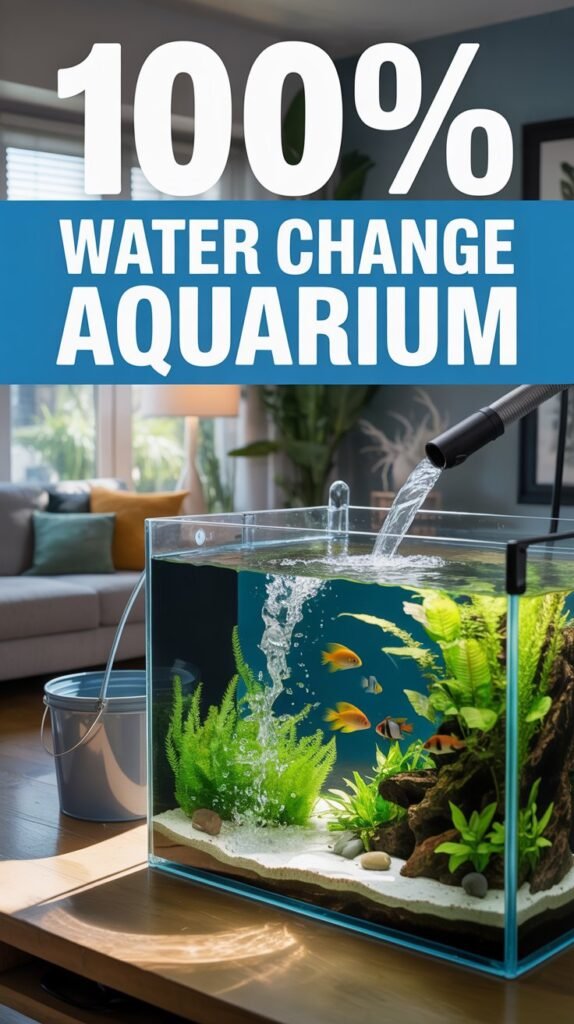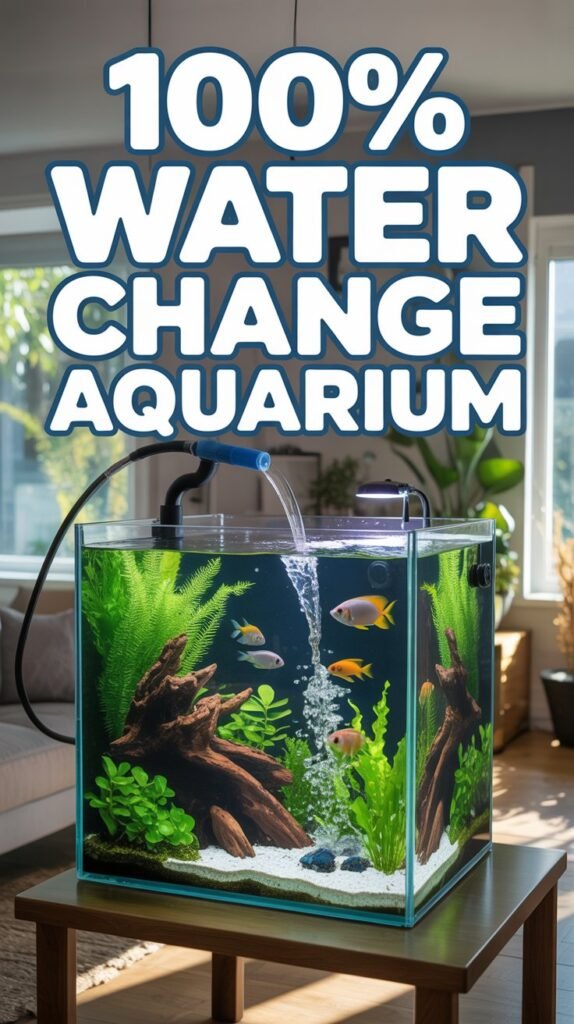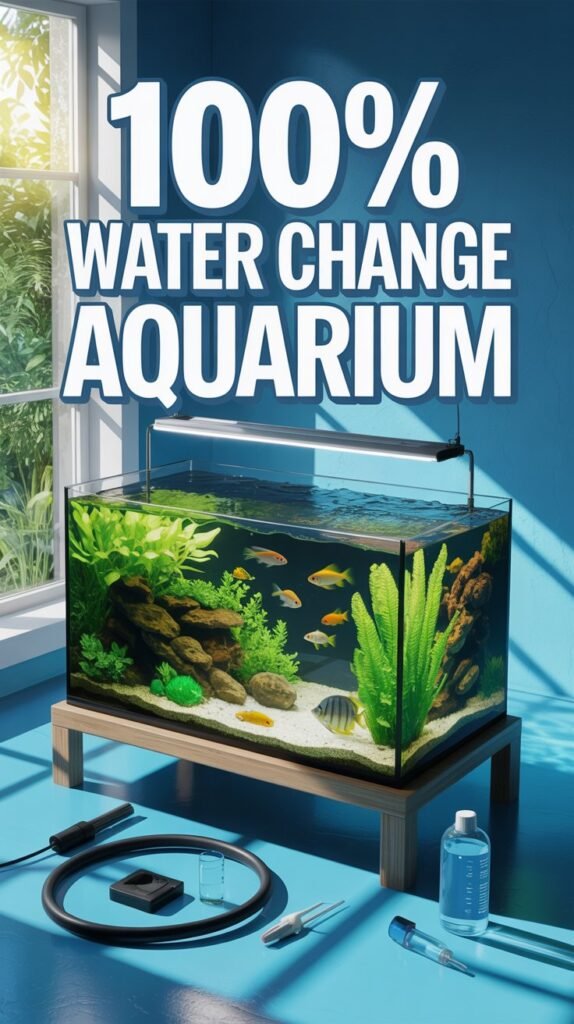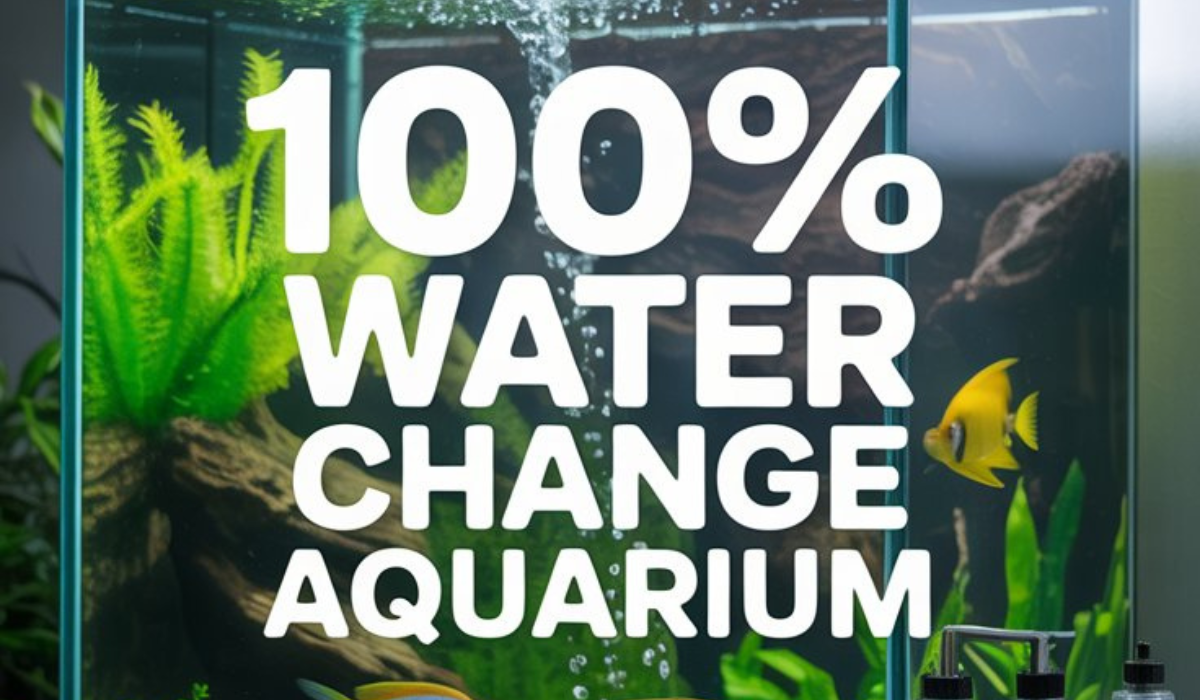Maintaining a healthy aquarium requires understanding the delicate balance of water chemistry, biological filtration, and aquatic life. One topic that often stirs debate among aquarists is whether or not performing a 100% water change in an aquarium is safe or necessary. While partial water changes are standard, there are situations where a complete water replacement may seem like the only option. However, doing it improperly can shock or even kill your fish.
In this guide, we’ll explore everything you need to know about 100% water changes, including when it’s necessary, the risks involved, how to do it correctly, and how to prevent needing one in the future.
Understanding Aquarium Water Changes
Water changes are one of the most fundamental parts of aquarium maintenance. They help remove excess waste, replenish essential minerals, and keep your aquatic environment healthy.
- Partial Water Change (Recommended Routine): Typically involves replacing 10–30% of the water weekly or biweekly.
- 100% Water Change (Full Replacement): Replacing all the water in the tank, effectively restarting the aquarium’s water parameters.
Partial water changes are designed to maintain biological balance without disturbing the beneficial bacteria living in your substrate and filtration media. However, a full or 100% water change wipes out that equilibrium, which can have severe consequences if not done properly.
Why Would You Do a 100% Water Change?

While full water changes are risky, certain situations may demand them. Here are some of the main reasons aquarists resort to a complete water replacement:
1. Toxic Contamination
If chemicals like soap, cleaning agents, pesticides, or heavy metals accidentally enter the tank, they can quickly poison the fish. In such cases, a 100% water change might be the only way to save your aquarium inhabitants.
2. Massive Algae Bloom
A severe algae outbreak that clouds the water, blocks light, and suffocates plants or corals might require a complete clean-up. However, this should only be done after identifying and correcting the root cause (e.g., excess light or nutrients).
3. Disease or Parasite Outbreak
During severe disease outbreaks (like ich or fin rot) that infect the entire tank, some aquarists perform a full water change to reset the environment after disinfecting it.
4. Tank Reset or Substrate Replacement
If you’re changing the substrate, moving the aquarium, or completely redesigning your aquascape, a 100% water change is unavoidable.
5. Ammonia or Nitrite Spike
In cases where ammonia or nitrite levels skyrocket to dangerous levels, replacing all the water can provide temporary relief while you identify the underlying issue (e.g., overfeeding, dead fish, or filter failure).
Risks of Doing a 100% Water Change
Performing a full water change is not without risk. In fact, many fish die after such drastic actions because of shock or loss of biological balance.
Here are the primary dangers of performing a 100% water change:
1. Loss of Beneficial Bacteria
Beneficial bacteria responsible for breaking down ammonia and nitrites live mainly in your filter media and substrate. When you change all the water, you disturb or kill much of this bacteria, causing the nitrogen cycle to restart.
2. Osmotic Shock
Fish adapt to specific water parameters (pH, hardness, temperature). A sudden and drastic change in these conditions can cause osmotic shock, leading to stress or death.
3. pH Fluctuations
New water often has a different pH than the old tank water. A sudden shift in pH can be fatal, especially for sensitive species like shrimp or discus fish.
4. Temperature Shock
Even a few degrees of difference between old and new water can cause thermal shock. Fish rely on stable temperatures to regulate their metabolism and immune systems.
5. Chlorine and Chloramine
If tap water isn’t properly dechlorinated before adding it to the tank, it can kill both fish and beneficial bacteria within minutes.
How to Safely Perform a 100% Water Change

If you must do a full water change, it’s crucial to follow the correct procedure to minimize harm. Here’s a step-by-step guide:
Step 1: Prepare Backup Water
- Fill large clean containers or storage bins with dechlorinated tap water.
- Match the temperature of the new water to your aquarium’s current temperature.
- Adjust the pH, hardness, and salinity (for saltwater tanks) to match the existing parameters as closely as possible.
Step 2: Remove Fish Safely
- Transfer your fish to a temporary holding tank or bucket with some of the old tank water.
- Add an air stone or small sponge filter to keep oxygen levels stable.
- Avoid overcrowding or long holding times.
Step 3: Turn Off Equipment
Unplug filters, heaters, and air pumps before draining to prevent damage or electrical hazards.
Step 4: Drain the Tank
- Use a gravel vacuum or siphon hose to remove all water.
- Clean debris from the substrate, glass, and decorations if necessary.
- Avoid using soap or harsh chemicals—stick to hot water and aquarium-safe cleaning tools.
Step 5: Clean and Rinse Filter Media
- Gently rinse your filter sponges or media in old tank water (not tap water) to preserve as much beneficial bacteria as possible.
Step 6: Refill the Tank
- Slowly refill the aquarium using the prepared water.
- Pour the water gently onto a plate or plastic bag placed on the substrate to prevent disturbance.
- Once full, add a water conditioner again to ensure full dechlorination.
Step 7: Acclimate Fish
- Float the holding container in the tank for 15–20 minutes to equalize temperature.
- Gradually mix tank water into the container before releasing fish back into the aquarium.
Step 8: Monitor Closely
- Test ammonia, nitrite, and nitrate levels daily for a week.
- If ammonia or nitrite levels rise, perform small partial water changes and add beneficial bacteria supplements.
Alternative to 100% Water Change: Safer Options
Unless absolutely necessary, you should avoid complete water replacement. Here are safer alternatives:
1. Partial Water Changes (20–30%)
This method helps control toxins and refresh minerals while maintaining stability. It’s the best long-term maintenance routine.
2. Use of Activated Carbon or Chemical Filtration
Activated carbon or resins like Purigen can remove toxins without disturbing the tank’s balance.
3. Bacterial Boosters
Adding bottled bacteria (like Seachem Stability or Tetra SafeStart) can help restore biological balance after a water change.
4. Vacuuming and Spot Cleaning
Instead of full replacement, you can use a gravel vacuum to remove detritus and uneaten food, keeping your tank clean and balanced.
5. Water Polishing Filters
If your tank water looks cloudy, use a polishing filter pad or diatom filter to clear it up without replacing all the water.
How Often Should You Change Aquarium Water?

For most aquariums:
- Freshwater tanks: 20–25% weekly or biweekly.
- Planted tanks: 15–20% weekly to maintain nutrient balance.
- Saltwater tanks: 10–15% weekly or 25% monthly, depending on bioload.
Over-cleaning or performing full water changes too often can destabilize the nitrogen cycle.
Tips to Prevent Needing a 100% Water Change
To maintain long-term stability and avoid drastic measures, follow these best practices:
- Test Water Regularly: Use aquarium test kits to monitor ammonia, nitrite, nitrate, and pH.
- Feed Sparingly: Overfeeding is a leading cause of water quality problems.
- Maintain Filters Properly: Clean filters monthly using tank water.
- Add Live Plants: They absorb nitrates and improve oxygenation.
- Perform Regular Partial Water Changes: Consistency is key to a healthy tank.
- Avoid Overcrowding: Keep fish numbers appropriate for your tank size.
- Quarantine New Fish: Prevent diseases from entering your established aquarium.
What to Expect After a 100% Water Change
After a complete water change, your aquarium essentially restarts. You may notice:
- Cloudy water for the first few days as bacteria reestablish.
- Minor fish stress or hiding behavior.
- Small ammonia spikes if the bacterial colonies were disturbed.
To help stabilize:
- Add bacterial supplements and water conditioners.
- Keep the filter running 24/7.
- Avoid feeding for 24 hours after refilling.
Within 5–7 days, parameters should stabilize if the process was done carefully.
Conclusion
Performing a 100% water change in an aquarium is a drastic measure that should only be done in emergencies or during major tank overhauls. While it can help remove toxins and reset a contaminated system, it also poses significant risks if done incorrectly.
For long-term success, focus on regular partial water changes, biological balance, and proper filtration. By maintaining stable water parameters and avoiding overcleaning, your aquarium will thrive naturally—without the need for drastic interventions.
FAQs About 100% Water Change Aquarium
1. Can I do a 100% water change in my fish tank?
Yes, but it’s risky. It should only be done in emergencies or when resetting a tank. Always match the temperature, pH, and hardness to avoid shocking your fish.
2. How long does it take for a tank to recover after a full water change?
It can take 3–7 days for beneficial bacteria to reestablish, depending on your filtration and bacterial additives.
3. Will a 100% water change kill beneficial bacteria?
Yes, most beneficial bacteria will be lost, especially from the water column. However, some remain in the substrate and filter media if not completely cleaned with tap water.
4. How often should I perform a 100% water change?
Never routinely. It should only be done in cases of contamination, disease, or tank reset. Regular partial changes (20–30%) are better for stability.
5. Can I do a 100% water change for betta fish or goldfish?
It’s possible, but not recommended. These fish are sensitive to sudden changes. Instead, perform smaller, gradual water changes.
6. What’s the safest way to perform a 100% water change?
Prepare conditioned, temperature-matched water, move fish to a holding tank, clean gently, and slowly reintroduce them to the refilled aquarium.
7. Should I clean the filter during a 100% water change?
Yes, but rinse filter media in old tank water, not tap water, to preserve bacteria.
8. Why did my fish die after a 100% water change?
Likely due to shock from sudden changes in pH, temperature, or chlorine exposure.

